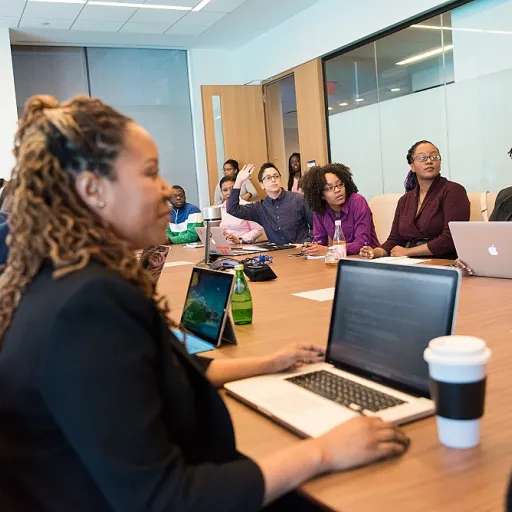
Understanding the Role of a Learning Strategist
The Vital Role of Learning Strategists in Change Management
In the dynamic world of business, change is not just inevitable; it's essential for growth and sustainability. This is where learning strategists come into play, acting as pivotal figures in guiding organizations through the complexities of change management. Their role is multifaceted, involving the development and implementation of learning strategies that align with business goals and support the workforce in adapting to new processes and technologies.
Learning strategists work closely with human resources and management teams to design training programs that not only educate but also empower employees. By focusing on professional learning and development, they ensure that team members are equipped with the necessary skills to navigate change effectively. This involves creating tailored learning initiatives that cater to the diverse needs of learners, from students in a school setting to seasoned professionals in a corporate environment.
Moreover, learning strategists are instrumental in fostering a culture of continuous improvement. They help organizations identify training opportunities that can enhance decision-making processes and drive innovation. By leveraging technological advancements, they develop online learning platforms and programs courses that provide flexible and accessible learning options for all employees.
In essence, the role of a learning strategist is to bridge the gap between strategy and execution. They support the organization in achieving its business goals by ensuring that the workforce is prepared and motivated to embrace change. For a deeper dive into the complexities of change management, you can explore navigating the complexities of capital procurement in change management.
Key Skills for a Learning Strategist in Change Management
Essential Abilities for Championing Change
In the dynamic environment of change management, learning strategists take the spotlight, equipped with a rich toolbox of skills pivotal for success. Understanding learning and strategists' roles in aligning training with organizational objectives is fundamental. To guide your team through the change process effectively, certain aptitudes stand out as critical.- Effective Communication: Strategists must bridge communication between decision makers, human resources, and individual learners. Their role involves simplifying complex ideas, ensuring everyone from students to seasoned professionals feels involved and informed.
- Strategic Planning: Developing coherent learning programs is essential. Strategists need to align these initiatives with business goals and anticipate future needs, integrating training opportunities that support professional learning and growth within the team.
- Adaptability: In a world shaped by technological advancements, strategists work to revamp traditional approaches and embrace online learning. Flexibility allows them to innovate strategy learning, adapting to changes with agility.
- Problem-solving: Analyzing resistances and devising strategic solutions is key. This includes tailoring programs courses to fit the learning pace desired and needed by different groups and effectively managing any arising challenges.
- Empathy and Support: A learning strategist must foster an environment where students, teachers, and employees feel supported. This involves empathizing with their concerns and providing personalized guidance to ease transitions.
- Measurement and Evaluation: Evaluating the success of learning initiatives against privacy policy considerations and expected outcomes ensures that change efforts produce tangible results. This evaluation process is vital for refining future strategies.
Developing a Change Management Strategy
Crafting a Comprehensive Approach
Developing a change management strategy is a crucial step in ensuring the success of any organizational transformation. A learning strategist plays a pivotal role in this process by aligning the change initiatives with the business goals and the needs of the learners. The strategy should be comprehensive, taking into account the unique dynamics of the team, the available resources, and the desired outcomes.
Steps to Create an Effective Strategy
To create an effective change management strategy, consider the following steps:
- Assessment: Begin by assessing the current state of the organization and identifying the areas that require change. This involves understanding the existing learning programs, training opportunities, and technological advancements that can support the change.
- Goal Setting: Define clear, achievable goals that align with the business objectives. This ensures that the change initiatives are purposeful and directed towards measurable outcomes.
- Stakeholder Engagement: Engage with key stakeholders, including human resources, teachers, and students, to gather insights and foster a sense of ownership. This collaboration helps in tailoring the strategy to meet the diverse needs of the group.
- Resource Allocation: Allocate the necessary resources, including time, budget, and personnel, to support the implementation of the strategy. This may involve investing in professional learning and training programs to equip the team with the required skills.
- Communication Plan: Develop a communication plan to keep all parties informed and engaged throughout the process. This helps in managing expectations and reducing resistance to change.
Leveraging Learning Strategists
Learning strategists help in bridging the gap between the current state and the desired future state by designing and implementing effective learning initiatives. They work closely with the team to ensure that the strategy is not only implemented but also adapted as needed to address any challenges that arise. By doing so, they support the organization in navigating the complexities of change.
For a deeper understanding of the psychological aspects involved in change management, you can explore more about it here.
Overcoming Resistance to Change
Building Trust and Acceptance
Resistance to change is one of the most significant challenges that learning strategists encounter as they implement new training programs or guide organizational transitions. A strong change management strategy involves understanding the reasons behind this resistance and addressing them effectively.- Transparent Communication: Keeping students, teachers, and team members informed about upcoming changes is crucial. Transparency can help allay fears and provide clarity about the benefits this change will bring to the school, business, or learners involved.
- Involve Key Stakeholders: Bringing stakeholders into the decision-making process allows them to express concerns and have a say in the strategy learning. This inclusion fosters a sense of ownership and helps in building trust.
Engaging and Empowering the Team
To minimize resistance, it is vital to engage and empower your team through training opportunities that not only prepare them for technological advancements but also align with human resources goals. This empowerment helps in bolstering confidence as they adapt to new learning initiatives.- Tailored Learning Programs: Crafting training courses tailored to various learning styles ensures that all learners, be it students or professionals, receive the support they need to adapt. This approach helps mitigate anxiety around learning new systems or processes.
- Continual Support and Feedback: Support doesn’t end with the initial implementation; instead, encourage continuous feedback. This helps strategists work better by understanding where additional resources are needed to help ease the transition.
Highlighting Success Stories
Sharing previous success stories or case studies from other organizations, such as Brandon Hall or Hall Group, can serve to build confidence in the new learning strategy. The professional experiences of other strategists who have navigated similar changes successfully can offer reassurance and motivation. Resistance to change is a natural response, but by strategically addressing fears and concerns through transparency, involvement, and robust support, learning strategists can effectively guide their organizations through transitions.Measuring the Impact of Change Initiatives
Evaluating the Success of Change Initiatives
Measuring the impact of change initiatives in your organization is crucial for assessing both the effectiveness of your strategies and identifying areas for improvement. To achieve this, learning strategists can capitalize on various metrics and frameworks to ensure a comprehensive evaluation process. Here’s how they do it:
- Define clear objectives: Start by setting specific business goals that align with the change initiatives. These could range from enhancing team performance to increasing engagement in learning programs. By establishing clear expectations, strategists can better track progress over time.
- Conduct assessments: Conducting regular assessments helps gauge the readiness and response of different groups, such as teachers, students, and human resources personnel, to the changes. By collecting feedback from various stakeholders, organizations can identify areas of resistance or opportunities for further learning.
- Leverage training opportunities: Training sessions and learning programs should be continuously evaluated to ensure they are meeting the needs of learners. By assessing participation rates and feedback, strategists can make informed decisions on tweaking strategy learning modules or online courses.
- Monitor engagement: Engaging learners through professional learning communities and interactive platforms can increase the effectiveness of change strategies. Track engagement levels by reviewing participation in team activities, strategy forums, and student-teacher interactions within school or business settings.
- Analyze data-driven insights: Utilize technological advancements to collect and analyze data. By reviewing measurable outcomes, such as improved performance metrics or increased usage of learning programs, strategists can validate the success of change management initiatives and support decision making.
With these evaluation techniques, learning strategists help organizations not only implement change but also refine their approaches over time. This iterative process not only aids immediate change but also prepares a resilient framework for future initiatives, allowing businesses to adapt seamlessly to evolving circumstances. Through effective impact measurement, the hall group and brandon hall models exemplify how strategists work hand in hand with organizations to achieve lasting transformation.
Case Studies: Successful Change Management with a Learning Strategist
Illustrative Examples of Effective Implementation
Organizations frequently encounter challenges when attempting to implement new strategies or processes. In such contexts, learning strategists offer invaluable support. They are instrumental in shaping effective learning programs that facilitate the adoption of new changes.
Transformation through Tailored Learning Programs
A company in the technology sector experienced significant changes due to rapid technological advancements. The learning strategist devised customized training opportunities aligned with the organization’s business goals. This approach ensured that each department received requisite support, leading to a smoother transition.
- Training: Created a tiered structure of training programs offering various levels of complexity.
- Support: Initiated a peer support group, fostering a collaborative learning environment.
Engaging Schools in Change Management
Within a school facing curriculum updates, the role of a learning strategist was crucial. With the involvement of students, teachers, and the broader educational team, tailored strategies were employed to manage change effectively. The engagement process included professional learning opportunities designed to ease resistance among learners, encouraging a culture of acceptance.
- Learning Strategy: Developed student-centered learning paths, enhancing engagement and understanding.
- Teachers' Training: Conducted workshops to familiarize teaching staff with new methodologies.
Business Resilience through Strategic Change Management
A manufacturing firm faced operational hurdles due to market shifts. Guided by learning strategists, the company crafted a robust learning initiative targeting middle-management to facilitate improved decision making. This strategic alignment helped in bridging the gap between business goals and workforce capabilities.
- Capacity Building: Offered courses on adaptive leadership and strategic decision making.
- Program Structure: Implemented a blended learning model integrating online learning with in-person sessions.
In summary, organizations that strategically incorporate learning strategists into their change management initiatives can profoundly enhance their effectiveness. By leveraging personalized learning strategies and engaging diverse groups, from schools to corporate environments, businesses can successfully embrace change.













